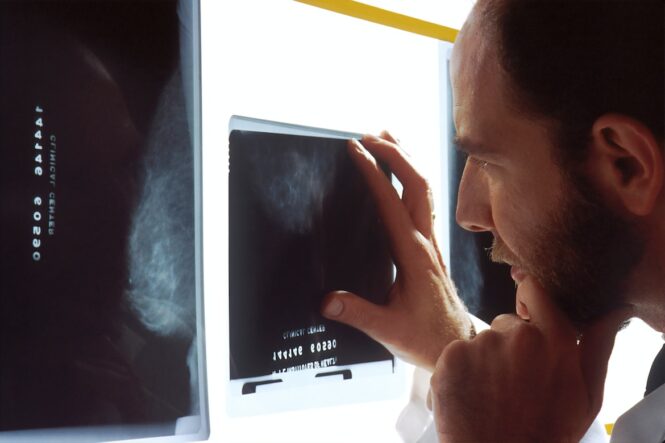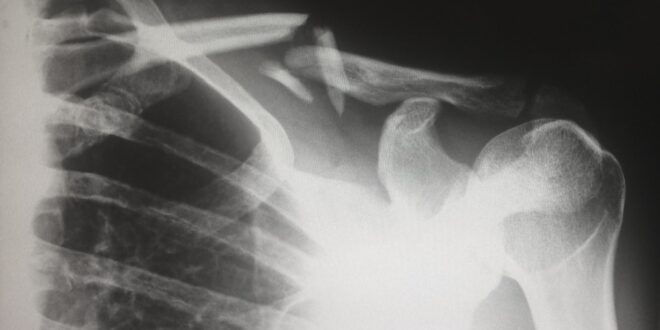A broken bone is medically referred to as a bone fracture.
Traumas like falls, auto accidents, or sports injuries frequently result in fractures. However, certain medical problems and repetitive motions (like running) can raise your chance of developing a certain kind of fracture.
You might require surgery to fix a broken bone. Some broken bones can heal with just a splint, cast, brace, or sling. How long it takes to recover depends on which of your bones are broken, where the break occurred, and what is the cause.
What type of bone fractures are there?
Fractures come in a wide variety of forms. Your doctor will determine which of the sort you have based on a few factors, such as:
- The word “fracture pattern” in medicine refers to the appearance or shape of a break.
- Cause: How fractures occur?
- Where on your body did you break a bone?
Symptoms of Bone Fracture

Its symptoms vary depending on the person’s age, location, and overall health. However, people experience some of the following symptoms:
- Pain
- Swelling
- Bruising
- Skin that is darkened around the afflicted area
- The afflicted portion protruding at an unusual angle
- Not able to bear weight on the damaged area
- A grating sensation in the bone or joint that is injured
- If the fracture is open, there is bleeding.
In more extreme situations, a person could encounter:
- Dizziness
- Lightheadedness or faintness
- Nausea
Major Causes of Bone Fracture
- Healthy bones are quite tough and can resist unexpectedly strong impacts. However, if you apply enough pressure, they might fracture.
- The main causes of bone fractures include physical trauma, excessive use, and illnesses like osteoporosis that weaken the bones. The chance of suffering might also be raised by other variables.
- As a person ages, their bones normally become weaker and are more prone to fracture. A disorder that weakens bones is more likely to occur as a person gets older as well.
Diagnosis of Bone Fracture

A physical examination and imaging studies will help your doctor determine whether you have a bone fracture. In some circumstances, if you are admitted following a trauma, this may be done in the emergency room.
If you are rushed to the ER, a group of medical professionals will stabilize you and treat your wounds according to their seriousness, especially if some of them are life-threatening. Imaging studies will be required following stabilization to confirm any of them.
Some tests for Fracture diagnosis
- X-rays: An X-ray will identify any fractures and demonstrate the degree of bone damage.
- An MRI may be used by your doctor to obtain a complete view of the damage to your bones and the surrounding tissue. Your ligaments and cartilage that surround your bones will also be visible on an MRI.
- A CT scan will provide your doctor or surgeon with as detailed a picture of your bones and surrounding tissue.
- Medical professionals use a bone scan to detect fractures that aren’t visible on an X-ray. This scan takes longer—typically two visits separated by four hours—but it can aid in the discovery of some fractures.
Which treatments are beneficial for Bone Fracture Healing?

NSAIDs that are available over the counter, such as aspirin or ibuprofen, might cause bleeding and other issues after surgery. The drugs you can take to lessen discomfort following surgery will be discussed with you by your surgeon.
But NSAIDs have some side effects on human health:
- Bleeding
- Ulcers
- Stomachache
- Intestinal complications
Pulsed electromagnetic field (PEMF) Therapy is considered the best therapy for the healing of the bone fracture. The heating radiation coming out of the PEMF mats or heating pad will release all your pain and rejoin your broken bone portion.
The use of this therapeutic ultrasound and shockwave therapy, among other noninvasive therapeutic tools, has improved tendon-to-bone repair after surgery. The Food and Drug Administration (FDA) has approved non-invasive devices that emit pulsed electromagnetic fields (PEMFs) for the treatment of long-bone non-union fractures and as an adjuvant to lumbar and cervical spine fusion surgery.
Researchers discovered about 40 years ago that PEMF therapy could be used to treat soft-tissue injuries, minimize hematoma, increase the rate of fracture healing, and reduce inflammation. However, there are few current studies on the possible impact of PEMF on tendon and tendon-to-bone repair.
PEMF Therapy – Beneficial for Fracture Healing
PEMF was first made available as a helpful therapy for fracture healing in the middle of the 1970s. PEMF is an efficient supplemental treatment for the management of un-united long-bone fractures, even though the mechanism is still poorly understood.
The majority of researchers wait to begin PEMF therapy until a confirmed nonunion has been identified, while some researchers think it should be used in cases with the late delayed union (more than 6 months following fracture).
Only a small number of researches have focused on the early use of PEMF immediately following the diagnosis of a delayed union (at around 16 weeks after fracture) and no studies have specifically examined the effectiveness of the early use of PEMF.
The Success of PEMF Therapy in Bone Fracture Healing

PEMF therapy in fracture healing uses Piezoelectric currents to induce bone regeneration. It can be challenging to stress a bone after a fracture and cause a piezoelectric current; as a result, pulsed electromagnetic frequencies have shown to be a useful substitute for replicating currents down the length of the bone in response to stress.
How well does PEMF work to treat fractures? Take a look at the findings of the research:
Low-magnitude voltage and currents are produced at the fracture site as a result of pulsed electromagnetic fields that induce fields through the soft tissue. When treating extremities non-unions, pulsed electromagnetic fields may be just as successful as surgery.
The purpose of the PEMF signal is to produce electrical fields in the bone that are comparable in size and onset to the endogenous electric fields generated in response to strain. These fields produce a time-varying extracellular and intracellular electrical field, which is thought to underpin bone’s capacity to adapt to a changing mechanical environment.
PEMF therapy is the only treatment for bone fracture healing without any side effects on your physical as well as mental health. Healthy Line is a platform where different kinds of therapy devices such as PEMF mats or heating pads are available to treat your bone fracture.
 Imagup General Magazine 2024
Imagup General Magazine 2024



